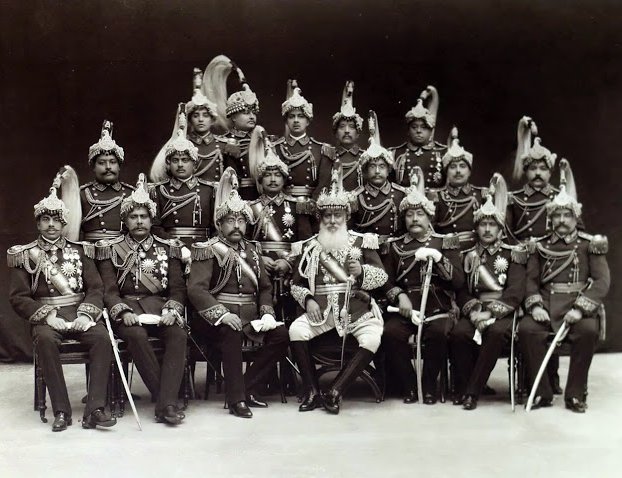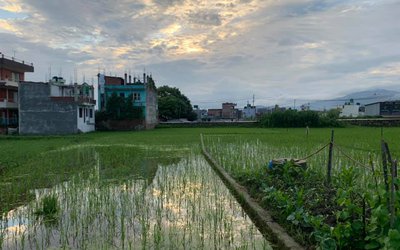
Preliminary
- This Declaration may be cited as the Government of Nepal Act, 2004 (1948)
- This Act shall come into force on 1st Baisakh, 2005, Sambat.
Provided that if it appears to His Highness that through local circumstances or other causes, it could not be practicable or convenient that all the provisions of this Act should come into force simultaneously on that date, he may, notwithstanding anything in this Section, fix an earlier or later date for the coming into force, either generally or for particular purposes or areas, of any particular provisions of this Act. All provisions of this Act shall, however, come into force throughout the Kingdom before the end of the year 2005, Sambat.
- The rule of succession relating of His Majesty the Maharajadhiraj Shree 5 and His Highness the Maharaja Shree 3 shall continue as hereto in force in accordance with law, custom and usage on their behalf and shall for all time be inalienable and unalterable.
Commentary
Article 1 of the Government of Nepal Act, 1948 takes the Act as Declaration. Article 2 makes clear that the Act will come into force on Baisakh 1, 2004 (13 April 1948).Notwithstanding this general rule, its proviso highlights that His Highness the Maharaja Shree 3may fix an earlier or later date for the coming into force, either generally or for particular purposes or areas, of any particular provisions of this Act. His Highness may conclude that it is not practical or convenient for all the provisions of this Act to come into force simultaneously on that date. The decision to fix an earlier or later date for the implementation of the provisions of the Act as are practicable would be based on the understanding of His Highness and local circumstances or other causes. Despite this discretionary power conferred on His Highness, the proviso assures that all provisions of this Act shall, however, come into force throughout the Kingdom before the end of the year Sambat2005 (i.e. 13 April, 1949).This one-year flexibility is thus supposed to help the process of planned enforcement of the Act. Article 3, the last Article on the preliminary section of the Act, holds that the rule of succession relating of His Majesty the Maharajadhiraj Shree 5 and His Highness the Maharaja Shree 3 shall continue as hereto in force in accordance with law, custom and usage on their behalf. It also holds that the rule will be inalienable and unalterable for all time. Following are further commentaries on some important aspects of the Preliminary part of the Act.
This Declaration may be cited as the Government of Nepal Act
The Government of Nepal Act was promulgated as a “Declaration.” It was a positive, explicit or formal statement that came from the prime minister as a proclamation. In this sense, the prime minister announced, avowed or proclaimed it. A declaration is made to affirm or state something emphatically.
There is a clear difference between “declaration” and “promulgation.” Generally, promulgation presupposes a process of approval before a declaration or formal proclamation is made. Even though a law is promulgated, it needs to be brought to public notice. This additional step is necessary before the law can take effect.
The Government of Nepal Act was not drafted by an elected parliamentary body, legislature or constituent assembly. It was not adopted by a house in the formal sense. Instead, it was drafted by experts and representatives of the Rana regime in consultation with the Prime Minister and with the assistance of external experts. The final draft that was declared as the Act was finalized by the Maharaja Shree 3himselfbefore such declaration was made and addressed to the public in a public forum. The last paragraph of the preamble of the Act uses the terms "ordain and promulgate" this Declaration as "Constitutional Act" by His Highness the Maharaja.
The Act was made available to the public through the publication in the Gorkhapatra Daily, the only and state-owned newspaper of the day.
The existing British standard in law making was different at that time, as the United Kingdom historically had a bicameral parliament. Acts of Parliament were promulgated when the King gave royal assent. The King could appear personally in the House of Lords, the upper House of the Parliament, to give his assent or could appoint Lord Commissioners to do seat a ceremony held at the Palace of Westminster for this purpose. However, royal assent was usually granted less ceremonially by letters patent.
The rule of succession relating of His Majesty the Maharajadhiraj Shree 5 and His Highness the Maharaja Shree 3,
In principle, a rule of succession is the sequence of those entitled to hold a high office or an honor, such as a title of nobility. The sequence is determined by the order in which they stand in line to succeeding the position when it becomes vacated. This sequence may be regulated through descent or by statute according to the prevailing traditions. Where there are hereditary positions, for example, in cases of many monarchies, an established order of succession is the standard way of passing on the title. Additionally, a rule of succession also provides immediate continuity when an unexpected vacancy occurs. Generally, a successor takes up the full role of the previous office-holder. In cases where there is no hereditary or statutory rule of succession, the succession requires succession planning to avoid power struggles prompted by power vacuums.
Article 3 of the Act gave validity, and therefore continuity, to the rule of succession not only to the throne of His Majesty the King of Nepal addressed as Shree 5, but also to His Highness the Rana Maharaja addressed as Shree 3.The Act did not reproduce the relevant rules in the Act, but only referred to them clearly. In the case of Nepal’s kings, according to the existing tradition, the succession to the throne was to be determined by absolute male primogeniture. In other words, the succession was to go to the eldest son of the reigning king upon his death or voluntary or forced retirement. In case the regnant king was a minor, absent, or incapacitated, the regent pro tempore was to be appointed to perform the role of the King, before the institution of Rana regime. Such an appointee could be the queen mother or one of the paternal uncles of the King, for example.
As far as His Highness was concerned, the basis of the rule of succession was the Panjapatra of August 6, 1856, which was given by King Surendra to Jang Bahadur Kunwar and could be conveniently translated as the royal charter. He was conferred the tile of Maharaja Shree 3 of Kaski and Lamjung, and both the title and property were hereditary in his family. The title came with the powers and privileges of a sovereign character. As such, he could exercise the powers and privileges not only within the area of his hereditary domains but also over the whole country between the Mahakali in the west and the Mechi in the east. According to Padmajang, the son of Jang Bahadur, these privileges were:
(1) the right to life and death;
(2) the power of appointing and dismissing all servants of government;
(3) the power of declaring war, concluding peace, and signing treaties with any foreign power, including the British, the Tibetans and the Chinese;
(4) the power of inflicting punishments on offenders;
(5) the power of making new laws, and repealing old laws, civil, criminal and military.
The Panjapatra also invested the succession of the position of prime minister to Jang Bahadur's seven brothers and then to Jang Bahandur’s sons and nephews according to seniority. It also authorized Jang Bahadur to coerce the King, should he mismanage the state affairs, internal or external. Jang Bahadur was thus a perpetual dictator on the model of the Roman Sulla; Sulla was a general and a statesman and one of the dictatorial canonical figures of Roman history. He ultimately possessed powers greater than any one person can safely or innocently hold.
After King Surendra's Panjapatra, Jang Bahadur Rana established the official Roll of Succession that ranked all his descendants in relation to their hereditary rights to the office of the prime minister. These provisions ensured that the dictatorship of the Kunwar family would be passed down in the family for generations. The Panjaptra did not provide any mechanisms that would restrain the power given to the Kunwar family. There was no legal mechanism for changing the government. In principle, the King could withdraw as he deemed necessary the position or power given to anybody. However, in a dictatorial regime, where the prime minister is stronger than the King, this authority depended not on the de jure but on de facto power to get things done.
Prime Minister Chandra Shamsher, who was the fifth Rana in power, revised the Roll of Succession in Rana family and divided the Rana clan of Nepal into three broad categories of A, B, and C. It was a radical formulation. According to Ramjee P. Parajulee, the basis of such formulation was the stature of the purity of lineage. A Class Ranas were those born of legitimate high caste, married wives. Only they could become prime ministers under this formulation and were entitled to the highest military and administrative positions. The following B Class Ranas were those born of legitimate married wives of secondary high castes or those born from marriage with a royal household member Class were those born of illegitimate wives of lower castes. All B and C Class Ranas could only become Colonel. The restructuring of the Roll of Succession was to narrow down the numbers of potential claimants of position and power. However, expectantly, it irritated many who were affected. Prime Minister Bhim Shamsher, who succeeded Chandra Shamsher, was also quick to give new orientation to the Roll of Succession. He demoted several of his nephews and promoted some of his C Class sons in the Roll. As such, Rana standards were fluctuating. However, that was still not final.
In March 1934, Juddha Shamsher expelled the C Class Ranas from the direct Roll of Succession. In fact, he announced the removal of his successor, Commander-in-Chief Rudra Shamsher, along with Maharaja Bhim Shamsher’s sons from his second wife from the Roll of Succession by making the Roll of Succession retroactive. Padma Shamsher was then elevated to the post of Commander-in-Chief of the Nepalese Army. This became fatal to the peace in the Rana oligarchy later. After Juddha Shamsher, nobody attempted to revise or redefine the Roll of Succession.
Earlier, before being offered the title of the Maharaja Shree 3, Jang Bahadur was offered felicitation by a group of men consisting of all the leading men of the country and headed by royal priest, Bijay Raj, as follows: "It is the universal wish of the nation to place the crown of our country upon Your Excellency's head, as the meekest token of the spontaneous gratitude of a loving people. The insignificant services of the meanest private are recognized by awards of medals and pensions: meet is it that such eminent services as have been done by Your Excellency for your country's lasting good, should not go without some fitting reward, wholly inadequate as all such will be to measure the worth of those services, or the depth of our gratitude in respect of them."
shall continue as hereto force
Article 3 makes it clear that the Act does not affect the rule of succession of the King as well as the Maharaja. The changes in the system of government that were introduced by the Act were on other issues, but not the law, customs, and usage regarding the rule of succession.
in accordance with law,
The word “law” here refers to the decrees (sanads) issued by the King and other rules of succession created or modified by the Maharajas.
custom and
The word “custom” here refers to the customs related to the rule of succession. It refers to the established patterns of behavior that can be objectively verified within the Shaha Rana dynastic setting. A claim can be carried out in defense of what has always been done and accepted by law. Related is the idea of prescription or the right enjoyed because of lasting customs rather than positive law. There is little committed in writing about these customs in Nepal. Apparently, if an issue comes up, it will have to be sorted out based on the written decrees and the study of customary laws and practices.
usage
Usage refers to long-continued, firmly-established, and generally-accepted practice or procedure in the matter of succession to which the people are accustomed. The decision is thus made on the basis of presumed familiarity.
in their behalf and
The phrase "in their behalf" refers to the behalf of the Kings and Maharajas. In other words, this phrase is to be interpreted to defend their rights.
shall for all time be inalienable and unalterable.
The Act legalizes monarchy and Rana rule for all time to come and makes them inalienable and unalterable. As they are inalienable, they are incapable of being alienated, surrendered, or transferred (unless the beneficiaries themselves desire it on their part). The words “inalienable “and “unalterable” are used in the legal sense, and their meaning cannot be overextended to guard against any revolution in the country.
[This article is part of the research work the author is conducting on the first Constitution of Nepal, issued in 1948. Detail references will be on the final product.]

Dr. Bipin Adhikari
Dr Adhikari is a senior constitutional expert and the founding dean of the Kathmandu University School of Law). He can be reached at [lawyers_inc_nepal@yahoo.com]
- Belt And Road: No Belt, No Road – The Stalled Journey In Nepal
- Oct 26, 2023
- On The Belt And Road Cooperation And Partnership 'Model Agreement'
- Oct 17, 2023
- Mobilizing Resources For The University Of Nepal
- Jul 06, 2021
- Insight Into The Political Economy Of Nepal’s Development
- May 27, 2021
- State Of Nepal’s Economy And Development Prior To The Introduction Of Padma Shamsher's Constitution
- Apr 20, 2020












